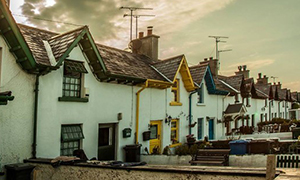January 13
Published in On this Day listing- 1941 James Joyce (58), writer, died in Zurich from a perforated duodenal ulcer; he was survived by his wife, Nóra, and son, Giorgio.
- 1843

Above: ‘Widows’ Row’, Newcastle, Co. Down—built with relief funds for the bereaved families most severely affected by the ‘Black Friday’ maritime disaster of 13 January 1843. (Mac Creative Photography)
The storms and gale-force conditions that ravaged these islands in January 1843 had devastating consequences off the Mourne coast. Early that fine winter’s morning, some sixteen skiffs set out from Newcastle and the nearby village of Annalong for their customary fishing grounds in Dundrum Bay. Conditions being exceptionally calm, the boats ventured further from the shore than usual. Then, about noon, disaster struck. Without warning, the wind veered from south to north-west, bringing violent gusts and blinding snow squalls howling down from the Mourne Mountains. Many of the boats were immediately swamped. Others vainly tried to make it to the shore, whilst a number of locals, watching in horror from the harbour, put to sea in a bid to rescue their stricken neighbours. Twelve of them would not return alive. A number were, however, rescued in shore-based efforts. One George Thompson from nearby Glasdrumman single-handedly hauled one boat ashore, saving the lives of its eight-man crew. Though there was no official count of how many were saved, 73 fishermen lost their lives, leaving 37 widows, 157 children and 42 other dependants, including eighteen aged parents. In the weeks that followed, appeals for relief funds, led by the local gentry and church congregations, raised over £1,000, a substantial sum for the time. Apart from financial relief, twelve cottages were built for the families most affected. ‘Widows’ Row’, as the locals call it, nowadays fully modernised, still stands today just above the harbour. ‘Black Friday’ was County Down’s worst maritime disaster until the MV Princess Victoria foundered in the North Channel in January 1953 with the loss of 133 lives.
- 1968 The 58-acre island Ireland’s Eye and 220 acres of the Hill of Howth, Dublin, were presented to the Irish state by Christopher Gaisford-St Lawrence.
- 1941 James Joyce, writer, died in Zurich from a duodenal ulcer.
- 1843 The Great Storm of Friday 13th claimed the lives of over 100 fishermen along the coasts of Ireland and Britain. Forty-six fishermen from Newcastle, Co. Down, along with 27 others from the nearby village of Annalong were drowned in Dundrum Bay.
- 1923 The home of W.T. Cosgrave, president of the Executive Council, was burnt down.
















